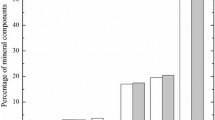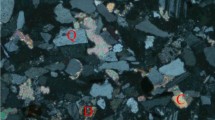Abstract
An experimental work is presented that aims to improve our understanding of water–rock reaction, under both neutral and acidic conditions, and its effects on the mechanical deterioration of sandstone in Chongqing, southwest China, where a lot of heritage rock statues are carved in the same strata. SCB tests were conducted to evaluate the weakening of fracture toughness of Chongqing sandstone after water and acid erosions, and a high-speed camera was employed to capture its cracking behaviors under different hydrochemical conditions. Microstructural observation was also carried out to investigate the cracking path at a micro-scale, and the chemical analyses of sandstone soaking water in a duration of up to 120 days allows to reveal the evolving process of water–rock reaction. The results show that compared to acid solutions of pH = 3 and 5, the strength weakening effect of distilled water on Chongqing sandstone is more severe. Crack propagation rates captured by the high-speed camera vary between 20 and 60 mm/s in the SCB tests. There is no significant difference in the data for dry and water-saturated samples, and the same for the samples in the two acid fluids. Yet the crack growth rates of the latter two groups are apparently greater than those of the former two. The chemical reaction between water / acid solutions and Chongqing sandstone is mainly pertinent to the cementation and grain boundaries, which weakens grain contacts and promote crack propagation. This mechanism results in a low KIC, long crack length, i.e., more tortuosity along grain boundaries, and high crack propagation rate.













Similar content being viewed by others
Abbreviations
- R :
-
Radius of the semi-circular specimen
- B :
-
Thickness of the semi-circular specimen
- a :
-
Initial crack length of the semi-circular specimen
- s :
-
Span length of load in semi-circular bend test
- K IC :
-
Fracture toughness
- v :
-
Crack velocity
- v 0 and n :
-
Constants
- H :
-
Activation enthalpy
- T :
-
Absolute temperature
- K I :
-
Mode I stress intensity factor
References
ASTM C1368-06 (2006) Standard test method for determination of slow crack growth parameters of advanced ceramics by constant stress-rate flexural testing at ambient temperature. In: Annual book of ASTM standards, vol 15.01. American Society for Testing and Materials
Atkinson BK, Meredith PG (1981) Stress corrosion cracking of quartz: a note on the influence of chemical environment. Tectonophysics 77(1–2):T1–T11
Atkinson BK, Meredith PG (1987a) The theory of subcritical crack growth with applications to minerals and rocks. Fracture mechanics of rock. Academic Press, London, pp 111–116
Atkinson BK, Meredith PG (1987b) Experimental fracture mechanics data for rocks and minerals. Fracture mechanics of rock. Academic Press, London, pp 477–525
Bahat D, Rabinovitch A, Frid V (2005) Tensile fracturing in rocks: tectonofractographic and electromagnetic radiation methods. Springer, Berlin
Baud P, Zhu W, Wong T-F (2000) Failure mode and weakening effect of water on sandstone. J Geophys Res 105(B7):16371–16389
Bell FG, Culshaw MG (1998) Petrographic and engineering properties of sandstones from the Sneinton Formation, Nottinghamshire, England. Q J Eng GeolHydrogeol 31(1):5–19
Brantut N, Heap MJ, Meredith PG, Baud P (2013) Time-dependent cracking and brittle creep in crustal rocks: a review. J Struct Geol 52:17–43
Brantut N, Heap MJ, Baud P, Meredith PG (2014) Mechanisms of time-dependent deformation in porous limestone. J Geophys Res Solid Earth 119(7):5444–5463
Charles RJ (1958) Static fatigue of glass. I J Appl Phys 29(11):1549–1553
Chen X, Huang J (2011) Stability analysis of bank slope under conditions of reservoir impounding and rapid drawdown. J Rock Mech Geotech Eng 3:429–437
China Academy of Cultural Relics and Heritage (2017) Geological characteristics of grotto rock mass in Sichuan and Chongqing area (internal report) (in Chinese)
Diederichs MS, Kaiser PK (1999) Tensile strength and abutment relaxation as failure control mechanisms in underground excavations. Int J Rock Mech Min Sci 36(1):69–96
Dong W, Yang D, Zhou X, Kastiukas G, Zhang B (2017) Experimental and numerical investigations on fracture process zone of rock–concrete interface. Fatigue Fract Eng Mater Struct 40(5):820–835. https://doi.org/10.1111/ffe.12558
Feng X-T, Ding W (2007) Experimental study of limestone micro-fracturing under a coupled stress, fluid flow and changing chemical environment. Int J Rock Mech Min Sci 44(3):437–448
Forbes Inskip ND, Meredith PG, Chandler MR, Gudmundsson A (2018) Fracture properties of Nash Point shale as a function of orientation to bedding. J Geophys Res Solid Earth 123(10):8428–8444
Grgic D, Amitrano D (2009) Creep of a porous rock and associated acoustic emission under different hydrous conditions. J Geophys Res 114:B10201
Grgic D, Giraud A (2014) The influence of different fluids on the static fatigue of a porous rock: Poro-mechanical coupling versus chemical effects. Mech Mater 71:34–51
Guo Z, Chen W, Zhang J et al (2020) Seismic responses of the densely distributed caves of the Mogao Grottoes in China. Bull Eng Geol Environ. https://doi.org/10.1007/s10064-020-02025-0
Hadizadeh J, Law RD (1991) Water-weakening of sandstone and quartzite deformed at various stress and strain rates. Int J Rock Mech Min Sci 28(5):431–439
Hawkins AB, Mcconnell BJ (1992) Sensitivity of sandstone strength and deformability to changes in moisture content. Q J Eng Geol Hydrogeol 25(2):115–130
Heap MJ, Baud P, Meredith PG et al (2009) Time-dependent brittle creep in Darley Dale sandstone. J Geophys Res 114:B07203
Heap MJ, Band P, Meredith PG et al (2011) Brittle creep in basalt and its application to time-dependent volcano deformation. Earth Planet Sci Lett 307:71–82
Hoek E, Bieniawski ZT (1965) Brittle fracture propagation in rock under compression. Int J Fract Mech 1:137–155
Kataoka M, Obara Y, Kuruppu M (2015) Estimation of fracture toughness of anisotropic rocks by semi-circular bend (SCB) tests under water vapor pressure. Rock Mech Rock Eng 48(4):1353–1367
Kim J, Kwon S, Sanchez M et al (2011) Geological storage of high level nuclear waste. KSCE J Civ Eng 15:721–737. https://doi.org/10.1007/s12205-011-0012-8
Ko TY, Kemeny J (2013) Determination of the subcritical crack growth parameters in rocks using the constant stress-rate test. Int J Rock Mech Min Sci 59:166–178
Kozisek F (2005) Health risks from drinking demineralised water. Nutr Drink Water 1(1):148–163
Kramarov V, Parrikar PN, Mokhtari M (2020) Evaluation of fracture toughness of sandstone and shale using digital image correlation. Rock Mech Rock Eng 53(9):4231–4250
Kuruppu MD, Obara Y, Ayatollahi MR, Chong KP, Funatsu T (2014) ISRM-suggested method for determining the mode I static fracture toughness using semi-circular bend specimen. Rock Mech Rock Eng 47(1):267–274
Lajtai EZ, Schmidtke RH, Bielus LP (1987) The effect of water on the time-dependent deformation and fracture of a granite. Int J Rock Mech Min Sci Geomech Abstr 24:247–255
Li YP, Chen LZ, Wang YH (2005) Experimental research on pre-cracked marble under compression. Int J Solids Struct 42:2505–2516
Lim IL, Johnston IW, Choi SK, Boland JN (1994a) Fracture testing of a soft rock with semi-circular specimens under three-point bending. Part 1—mode I. Int J Rock Mech Mining Sci Geomech Abstr 31(3):185–197. https://doi.org/10.1016/0148-9062(94)90463-4
Lim IL, Johnston IW, Choi SK, Boland JN (1994b) Fracture testing of a soft rock with semi-circular specimens under three-point bending. Part 2—mixed-mode. Int J Rock Mech Min Sci Geomech Abstr 31(3):199–212. https://doi.org/10.1016/0148-9062(94)90464-2
Lin M, Jeng FS, Tsai LS, Huang T (2005) Wetting weakening of tertiary sandstones—microscopic mechanism. Environ Earth Sci 48(2):265–275
Mallet C, Fortin J, Guéguen Y, Bouyer F (2015) Brittle creep and subcritical crack propagation in glass submitted to triaxial conditions. J Geophys Res Solid Earth 120:879–893
Mallet C, Fortin J, Guéguen Y et al (2015) Role of the pore fluid in crack propagation in glass. Mech Time Depend Mater 19:117–133
Mughieda O, Alzo’ubi AK (2004) Fracture mechanics of offset rock joints—a laboratory investigation. Geotech Geologic Eng 22:545–562
Nara Y, Morimoto K, Hiroyoshi N, Yoneda T, Kaneko K, Benson PM (2012) Influence of relative humidity on fracture toughness of rock: implications for subcritical crack growth. Int J Solids Struct 49(18):2471–2481
Rehbinder PA, Lichtman V (1957) Effect of surface active media on strain and rupture in solids. In: Proc. Int. Congr. Surface Activity, 2nd edn, vol III, pp 563–580
Trippetta F, Colletini C, Barchi MR, Lupattelli A, Mirabella F (2013) A multidisciplinary study of a natural example of a CO2 geological reservoir in central Italy. Int J Green Gas Cont 12:72–83
Wang Y, Li X, Yang ZF, Cui ZD, Shi XS (2015) Numerical study on the failure cracking process and associated acoustic emissions of Longyou No. 3 grotto pillars. In: Ancient underground opening and preservation: proceedings of the international symposium on scientific problems and long-term preservation of large-scale ancient underground engineering (23–26 Oct 2015, Longyou, Zhejiang, China). CRC Press, Boca Raton
Wang W, Li X, Zhu Q et al (2017) Experimental study of mechanical characteristics of sandy slate under chemical corrosion. Rock Soil Mech 38(9):2559–2573 ((in Chinese))
Waza T, Kurita K, Mizutani H (1980) The effect of water on the subcritical crack growth in silicate rocks. Tectonophysics 67(1–2):25–34
Wiederhorn SM, Johnson H (1972) Effect of electrolyte pH on crack propagation in glass. J Am Ceram Soc 56:192–197
Wiederhorn SM, Freiman SW, Fuller ER, Simmons CJ (1982) Effects of water and other dielectrics on crack growth. J Mater Sci 17(12):3460–3478
Wong LN, Einstein HH (2009) Using high speed video imaging in the study of cracking processes in rock. Geotech Test J 32(2):164–180
Xing HZ, Zhang QB, Braithwaite CH, Pan B, Zhao J (2017) High-speed photography and digital optical measurement techniques for geomaterials: fundamentals and applications. Rock Mech Rock Eng 50(6):1611–1659
Zang A, Wagner CF, Dresen G (1996) Acoustic emission, microstructure, and damage model of dry and wet sandstone stressed to failure. J Geophys Res 101(B8):17507–17521
Zhang M, McSaveney MJ (2018) Is air pollution causing landslides in China? Earth Planet Sci Lett 481:284–289
Zhang X, Spiers CJ (2005) Effects of phosphate ions on intergranular pressure solution in calcite: an experimental study. Geochim Cosmochim Acta 69(24):5681–5691
Zubtsov S, Renard F, Gratier J-P, Guiguet R, Dysthe DK, Trask-ine VY (2004) Experimental pressure solution creep of polymineralic aggregates. Tectonophysics 385:45–57
Acknowledgements
The authors are grateful to the National Natural Science Foundation of China for financial support under Grant No. 41877265.
Author information
Authors and Affiliations
Corresponding author
Ethics declarations
Conflict of Interest
The authors declared that they have no conflicts of interest in connection with the work submitted.
Additional information
Publisher's Note
Springer Nature remains neutral with regard to jurisdictional claims in published maps and institutional affiliations.
Rights and permissions
About this article
Cite this article
Xie, N., Sun, C. & Li, P. Effects of Aqueous and Acid Erosions on the Cracking Behavior of Sandstone Captured by High-Speed Camera During Semi-circular Bend (SCB) Tests. Rock Mech Rock Eng 54, 4147–4161 (2021). https://doi.org/10.1007/s00603-021-02504-0
Received:
Accepted:
Published:
Issue Date:
DOI: https://doi.org/10.1007/s00603-021-02504-0




